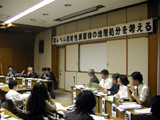Why Geological Disposal in Japan?
On 21 October 2000, CNIC sponsored a public debate entitled "Examining the Geological Disposal of High Level Radioactive Wastes." Following is a summary of the background and the discussions carried out between citizens and representatives of the Science and Technology Agency and the Japan Nuclear Cycle Development Institute (JNC) at the public debate.
The JNC has conducted research and development for the final disposal of Japan's radioactive wastes under the prescribed policy of "geological disposal," decided upon by the Atomic Energy Commission (AEC) in 1984. Last November, JNC released its "H12: Project to Establish the Scientific and Technical Basis for HLW Disposal in Japan," and the AEC indicated its agreement with the document's content. To facilitate the actual job of selecting the candidates for disposal sites, at the end of May the government passed the "Law for the Geological Disposal of Specified Radioactive Wastes," established and authorized a corporation called the "Nuclear Waste Management Organization of Japan" to perform the disposal, and designated the "Radioactive Waste Management Funding and Research Center" as the organization to manage disposal costs.
However, there has been no broad public discussion, as in the Diet, on the crucial matter of whether geological disposal is really acceptable for high-level wastes, or whether it is genuinely possible in Japan. On geological disposal we have no national consensus, only the AEC's arbitrary decision. In view of this situation, CNIC and the people living in areas considered for disposal sites believe we must carefully examine the government's plans for geological disposal, and rethink waste disposal solutions. The public debate was organized in response to such demands, and was attended by about 180 people.
Does Japan Have Any Stable Geological Formations?
The problems of geological disposal itself have been discussed worldwide, and what is more, Japan is in one of the world's active seismic zones, making it perhaps impossible to find a disposal site that is unaffected by earthquakes and underground fault activity in any area of the country.
While the proponents did admit that Japan is an area with frequent volcanic and seismic activity, it maintained that geological disposal is possible if volcanic zones are avoided and disposal sites are located far enough away from active faults. The proponents asserted that even if an earthquake occurs, safety can be assured because deep underground areas are not affected by earthquake movement as much as the surface is.
Citizens made the point that, as with the severe magnitude 7.3 earthquake that occurred in Tottori Prefecture in Western Japan in October (see News Watch p.11), earthquakes can occur in regions said to be free of active faults. They maintained that the effects of earthquakes on the ground are complex, making it impossible to say that a deep underground storage site would be safe. Citizens also contended that there is no scientific basis whatsoever for the assertion that a place will be unaffected by earthquakes over the more than 100 thousand years required before the radiation of high level wastes falls to a safe level. Therefore, they said, it is impossible to find an absolutely safe place.
In sum, the safety of geological disposal, as asserted by the proponents, is safety under an artificially conceived worst-case scenario; it is based on mere probability, and has no scientific underpinning. We must continue to actively discuss the disposal issue, and we shall continue to propose a quick nuclear power phase-out, which would help alleviate formidable problems, such as the burden imposed on future generations.
By Masako Sawai

